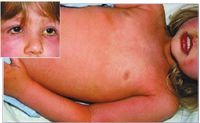Hot, red, and flaky-and not to be touched
A 3-year-old girl develops a red, dry, flaky rash over her body, and a dried, yellow crust around her eyes. What's the diagnosis?
The parents of a 3-year-old girl have brought her to see you because of a three-day history of sneezing, dry cough, and low-grade fever and, for the past day, a red, dry, flaky rash over the entire surface of her body (see the photograph). They also report a dried, yellow crust around her eyes that has become strikingly worse since yesterday.
The girl has been generally irritable and sleeping poorly. Her father notes that she is reluctant to be picked up or touched, and her appetite is diminished. The parents deny shortness of breath, wheezing, or a change in bowel or bladder habit.
Your patient has been in generally good health, growing and gaining weight and height appropriately and meeting all major developmental milestones. Vaccinations are up to date.
There is a copious amount of purulent, yellow discharge emerging bilaterally from the inner canthi (see the inset photo). You note scleral injection bilaterally. There is also purulent rhinitis. The pharynx is beefy red but without exudates; tonsils are grade II/IV. You do not see any change to the mucous membranes. There is tender lymphadenopathy. Heart and lungs are clear; no murmurs are appreciated; there are no rhonchi or wheezing; and no respiratory distress is apparent.
Diagnosis: Staphylococcal scalded skin syndrome

In the United States, phage group II staphylococci most commonly produce epidermolytic toxins A and B. The toxins bind to desmoglein 1 within the desmosome,1 thereby disrupting the normal function of the desmosome-which is to anchor adjacent skin cells to each other. This disruption results in formation of tense bullae, although these are often no longer intact at presentation because of their fragility.
Who is at risk?
The basis of the pathophysiology of SSSS is twofold: lack of immunity to, and impaired renal clearance of, the epidermolytic toxins-both of which explain why SSSS occurs mostly in children younger than 2 years and almost exclusively in children younger than 6 years. SSSS in an adult almost certainly signals an underlying comorbid condition, such as an immunosuppressive disorder or renal insufficiency.2
How is the diagnosis made?
Staphylococcal scalded skin syndrome can be diagnosed by the history and physical exam. Despite the origin of the syndrome in an infection with a toxigenic strain of S aureus, the primary focus of infection may be occult. It is not uncommon, therefore, for the presentation to be solely one of skin involvement without a history of either otitis media or conjunctival or pharyngeal symptoms.
The rash of SSSS typically progresses from a scarlatiniform eruption to a blistering eruption, followed by desquamation. The rash is tender and, typically, diffusely involves the entire body except for the mucous membranes. On gentle pressure, the superficial layer of the epidermis can be separated and slipped off-known as a positive Nikolsky sign.
Patients may also be irritable and have a low-grade fever and malaise. They do not appear toxic.
If you suspect a diagnosis of SSSS, but are worried about Stevens-Johnson syndrome or another disorder that might mimic SSSS, punch biopsy can be performed to reveal the characteristic noninflammatory split within the epidermis.2,3
Recognize & Refer: Hemangiomas in pediatrics
July 17th 2019Contemporary Pediatrics sits down exclusively with Sheila Fallon Friedlander, MD, a professor dermatology and pediatrics, to discuss the one key condition for which she believes community pediatricians should be especially aware-hemangiomas.